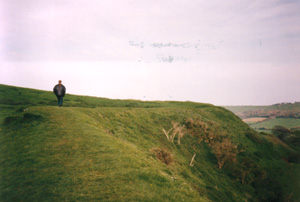
![]()
CADBURY CASTLE
Thought to be the most likely location of
The steep ascent up to Cadbury Castle.
Looking across the plateau atop the castle,
Walking along the ridge which rings the plateau.
Aerial view of the Castle.
Diagram of the castle showing archeological finds.
A survey was carried out in July 1966, in order to make a contour plan of the hill, (and thus establish which parts of the hilltop were suitable for building), and also take profiles across the defensive earthworks, (lines AB, CD in the plan). On the basis of this survey, trial excavations were undertaken at sites A, B and C. SiteA produced evidence that the decayed, pre-Roman rampart has been refortified at a later date,
while sites B and C revealed tantalising possibilities of extensive occupation, trace of an Iron-Age house and several large post-holes, once containing supports of substantial buildings.
Further scientific investigations in 1967 showed series of parallel trenches and rows of holes in the bedrock, superimposed on one another, suggesting that Cadbury had been continuously refortified from the IronAge onward. A new site (EFG) was chosen for excavation and a section (D) was cut down through the four banks. This section, together with the three that followed, pinpointed the highly sophisticated fortifications of a late Saxon " burgh," below which was uncovered ramparts built upon the original foundations, and built of timber, stone and earth and rubble very much in the Celtic tradition. These ramparts were certainly not pre-Roman, as they lay above a level where Roman pottery was found.
Tintagel
-
Glastonbury Tor
-
Chalice Well -
Cadbury Castle
-
Glastonbury Abbey
-
Stonehenge
the real Arthur's headquarters.![]()

![]()
to the ridge where the land drops away in tiers.![]()

![]()
photo scanned from 'The Realm of King Arthur' by Graham Ashton![]()
click on the plan for a larger version.
plan and text below scanned from 'The Realm of King Arthur' by Graham Ashton
In the 6th century, a powerful British leader, wealthy enough and still sufficiently civilised to have kept some of the habits of Romano-British civilisation, and to have been about to import from the continent wine contained in jars of eastern Mediterranean origin, reoccupied Cadbury Castle in force with a large band of warriors and erected within the ramparts residential buildings of a more or less permanent character" (R. F. Treharne).